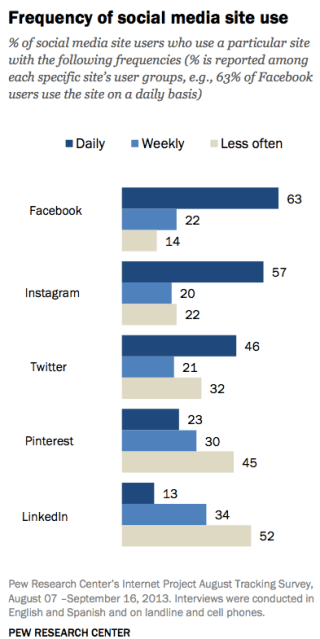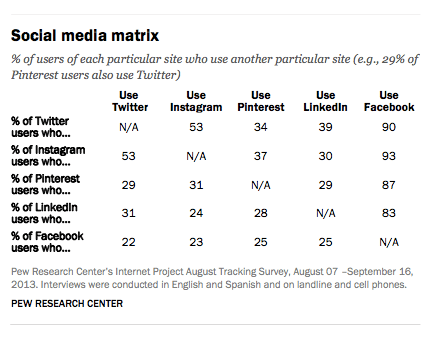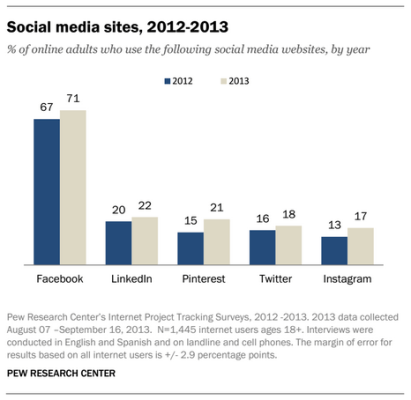Facebook may be currently facing question marks over how well it’s faring with younger users, but among those over 18 in the U.S. it remains the social network king. According to figures out today from the researchers at the Pew Research Center, the percentage of adults using the social networks of Facebook, LinkedIn, Pinterest, Twitter or Instagram to communicate with each other is now at 73%, and Facebook — the world’s largest social network with 1.19 billion users — remains the most popular in the U.S., with 71% of U.S. adults using it.
In other words, nearly all adults that responded that they are on a social network are using Facebook. That’s four percentage points up from last year’s 67%, Pew notes. It comes at a time of heightened competition: partly thanks to the rise of mobile apps — the number of people on multiple networks is now at 42%.
Among the top five networks (as charted by Pew), there is a lot more wiggle room for who comes in second after Facebook. LinkedIn — site that bills itself as the “professional” social network focused on networking, job hunting and professional information and news — is hanging on at number-two, with 22% of U.S. adults using it — up 2% on last year. Close behind it is Pinterest — which has vaulted over Twitter to number-three position with 21% usage.
Twitter — despite the different services that it has launched to increase engagement like Twitter Music other discovery services; and despite the increased attention around its IPO — has only grown by two percentage points to 18%. Hot on its heels is Instagram at 17%.
Google+ does not make it into the top-five mix — not because of its lack of popularity; but because Pew says it did not include it in its survey questions.
Indeed, Pew’s numbers reveal a bit, confirm a bit of what we might have already guessed, but also leave a few blind spots. While there is a 42% overlap of usage across multiple sites, some 36% of respondents said that they only used one social network, and Pew notes that “22% did not use any of the five specific sites we asked about.” That could mean they used services like Google+, Snapchat, something else entirely, or nothing at all.
How many versus how often
 For these sites, which are constructed in large part around advertising-based business models, critical mass is crucial: you won’t visit a site if no one else is using it. Similarly, on the commercial side of the equation, one of the key metrics that the sites, and their advertisers, like to focus on is engagement.
For these sites, which are constructed in large part around advertising-based business models, critical mass is crucial: you won’t visit a site if no one else is using it. Similarly, on the commercial side of the equation, one of the key metrics that the sites, and their advertisers, like to focus on is engagement.
It’s interesting, therefore, that when it comes to frequency of use, the rankings change. Facebook continues to remain at the top in the daily rankings, with 63% of people accessing it on a daily basis. Instagram — last in the general rankings — is not far off and in second place, with a 57% daily use. Similarly, its weekly and “less often” rates are also close, respectively at 22%/20% and 14%/22%. (This goes some way towards explaining why Facebook was keen to acquire it: their usage patterns are very close.)
Twitter may overall be seeing less usage in general than Pinterest but those who are on it appear more engaged: some 46% of Twitter users are on it daily for their quick fix of quips made and received. Pinterest, in contrast, has a fairly low rate of daily usage, with 23% of its users visiting on a daily basis.
Facebook, Instagram and Twitter also are generating a significant amount of mulitple-times-per-day use, with 40% at Facebook, 35% at Instagram and 29% at Twitter, Pew says.
LinkedIn, meanwhile, has a lot of work to do, with only 13% of its users going there daily. Are those the ones looking for work? In any case, this is another way of explaining why it is that LinkedIn has tried to overhaul its whole content operation, to create something that will attract people to visit it more frequently than just “less often.”
Pew notes that for now it looks like Facebook is partly winning because of how it has managed to appeal to a wide range of users — a pretty impressive turn for widening its reach, considering that it started out as a network restricted only to university networks.
The demographic data for other networks stands in contrast to this: Pinterest “holds particular appeal to female users”, with women four times more likely as men to be Pinterest users; LinkedIn is “especially” popular among college graduates and internet users in higher income households. Twitter and Instagram resonate with urbanites and younger adults, and non-whites. (Facebook has over 70% usage among whites, Hispanics and black users, Pew notes.) All of them, excepting LinkedIn, has its highest proportion of users in the 18-29 age bracket; LinkedIn is more popular with the 30-49 group.
Among those who say they use only one social networking site, Facebook is a clear winner with 84% selecting it as their sole site, with the others lagging behind by a very far stretch: 8% solely use LinkedIn, 4% solely use Pinterest, and Instagram and Twitter each picked up only 2% — positioning them as firmly secondary in the U.S. market today.

